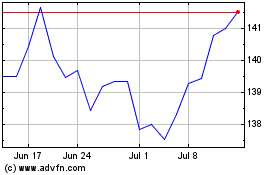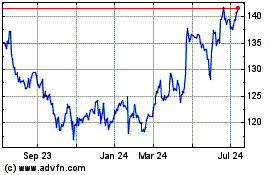Kimberly-Clark's Earnings Rise on Cost Cuts, Lower Tax Rate -- Update
April 22 2016 - 12:10PM
Dow Jones News
By Sharon Terlep
The battle for the Chinese shopper has created a price war among
companies that sell consumer staples from paper towels to diapers,
making it even harder for businesses to wring a profit out of the
critical market.
Kimberly-Clark Corp., the maker of Huggies diapers and Kleenex
tissues, on Friday reported lower first-quarter sales around the
globe despite higher volumes in many regions and categories.
Currency volatility due to the strong dollar was the biggest drag
in most regions outside the U.S.
In China, the Dallas-based company lowered prices to combat
competition from local firms as well as rivals from Japan and other
nations.
"More and more people are coming into the middle class and
parents really invest in their children," Kimberly-Clark Chief
Executive Thomas Falk said in an interview. "At the same time, it's
a competitive market. Everyone in the world sees that billion-plus
population and is moving in."
China helped fuel a 2% increase in sales volume of personal-care
goods, such as baby wipes and feminine hygiene products, in
emerging markets. But while prices for those products rose in Latin
America and Eastern Europe, Kimberly-Clark relied on profit-eroding
promotions in China to hang on to market share.
"It got a little more expensive there," Mr. Falk said.
Shares of Kimberly-Clark fell 4.4% in morning trading Friday.
Rival Procter & Gamble Co. is slated to report its latest
results Tuesday, and analysts expect the company to report lower
profit and sales.
Competition in China was particularly evident in the lucrative
diaper market where Kimberly-Clark's organic sales, which strips
out the effects of currency moves and acquisitions, rose 5% for the
period compared with a 35% increase a year ago.
Elsewhere around the world, Kimberly-Clark benefited from an
improving U.S. economy, noting that American consumers have been
willing to shell out more for items like improved diapers. Strength
in U.S. has helped offset weakness abroad, where the stronger
dollar makes U.S. goods more expensive and where economies have
been softer.
In the first quarter, U.S. sales increased 3%, driven by higher
volumes across the company's product lines. Total sales slipped
4.6% from a year earlier to $4.48 billion, falling short of the
$4.54 billion analysts projected.
Despite the sales decline, profit rose as the company took down
expenses and benefited from lower commodity prices and a lower tax
rate. Kimberly-Clark reported a profit of $545 million, or $1.50 a
share, up from $468 million, or $1.27 a share, a year earlier.
Mr. Falk said he sees more opportunities to cut costs,
particularly through increasing the efficiency of its manufacturing
operations. "There is still a big difference in the productivity of
our weakest performing plants and the best performing plants," he
said.
The company brought overhead expenses down by 2.8% to $825
million and lifted its gross margin to 36.6% from 35.4%.
Kimberly-Clark's tax rate was 28.3% during the quarter, down from
33.8% a year earlier.
For the year, the company backed its previously-issued
forecast.
Lisa Beilfuss contributed to this article.
Write to Sharon Terlep at sharon.terlep@wsj.com
(END) Dow Jones Newswires
April 22, 2016 11:55 ET (15:55 GMT)
Copyright (c) 2016 Dow Jones & Company, Inc.
Kimberly Clark (NYSE:KMB)
Historical Stock Chart
From Aug 2024 to Sep 2024

Kimberly Clark (NYSE:KMB)
Historical Stock Chart
From Sep 2023 to Sep 2024
